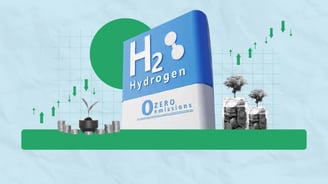Add your promotional text...
Why Green Hydrogen Stocks must in your watchlist: The Future of Sustainable Energy
Synopsis: Green hydrogen is emerging as a vital player in the clean energy landscape, offering a sustainable alternative to fossil fuels. This comprehensive guide explores its growing importance, significant global investments, and its potential to transform India’s energy sector. By contrasting lithium-ion batteries with hydrogen fuel cells, we highlight the advantages and challenges of green hydrogen, presenting a promising opportunity for investors in the new age of fuel innovation.
INVESTMENT IDEAS
By Runjhun Tripathi
8/8/20243 min read


Green hydrogen isn’t a widely discussed fuel yet, but its potential is significant. In the realm of automotive energy, electric power is often heralded as the future. However, the supply chain limitations of metals and minerals for lithium batteries suggest that green hydrogen might soon become a pivotal player in the clean energy landscape.
The Growing Importance of Green Hydrogen
The Need of the Hour
The sun, through its hydrogen fusion processes, is the primary source of all energy on Earth. Fossil fuels are essentially stored solar energy from the biological cycles of plants and animals over millions of years. According to India’s Union Ministry of Statistics and Programme Implementation, the country produced 15,311 petajoules of energy in 2020, with 81% coming from coal, oil, and natural gas. Fossil fuels, despite their environmental impact, have been the dominant energy source for decades.
By 2040, India is projected to produce 35,825 petajoules of energy. According to the International Energy Agency (IEA), a transition to alternative, clean energy sources is crucial. Green hydrogen, derived sustainably from the sun’s energy, represents a significant shift from finite fossil fuels. It is produced by splitting water into hydrogen and oxygen using an electrolyzer powered by renewable energy sources such as wind and solar. This shift could be transformative for India, which currently imports 85% of its oil and 53% of its gas demand.
Governments worldwide are increasingly supporting green hydrogen projects to reduce greenhouse gas emissions, particularly in heavy industries like freight, steel, and energy storage. However, achieving the necessary hydrogen production for global transportation requires rapid advancements in production methods.
Investments in Green Hydrogen
Significant investments are being made in green hydrogen globally. According to data from the IEA and Niti Aayog, countries are committing substantial public and private funds:
Italy: $11.9 billion
Germany: $10.2 billion
Spain: $10.2 billion
India: $9.8 billion
France: $8.1 billion
US: $7.6 billion
Japan: $3.4 billion
Australia: $2.4 billion
Netherlands: $1.2 billion
Renewable energy has been at the forefront of India’s green initiatives for decades. Diversifying electricity sources by incorporating renewable energy into the grid is helping India achieve its Paris Agreement targets. The country has pledged to achieve 40% installed capacity from renewable energy sources by 2030, aiming to reduce emissions by 33-35% below 2005 levels.
India’s National Hydrogen Mission aims to establish giga factories for green hydrogen production. While it is too early to predict if green hydrogen will become the primary fuel for India’s infrastructure, the success of these initiatives depends on a balanced mix of intra and inter-sectoral policies. The decisions made today will significantly impact India’s future energy landscape.
Lithium Versus Hydrogen
The rise of hydrogen fuel cells does not spell the end for lithium batteries. Lithium, despite its reactive nature, is crucial in our increasingly electronic world. Lithium-ion batteries have limitations in power density compared to hydrogen fuel cells. A hydrogen tank’s range can be easily extended with incremental changes in size, and hydrogen fuel cells maintain their range better over their lifecycle than lithium-ion batteries.
Companies like Amara Raja Batteries are expanding their lithium battery production capacities. Meanwhile, India plans to produce lithium-ion cells domestically, reducing reliance on imports and making electric vehicles (EVs) more affordable. Companies such as Tata Chemicals, Tata Power, and Exide are investing in battery technology and charging infrastructure, which will eventually make lithium batteries more accessible.
Green hydrogen also offers geopolitical advantages. India currently lags in securing key raw materials like lithium and cobalt, areas where China has a significant lead. Green hydrogen, still in its early stages globally, provides India with an opportunity to gain a competitive edge. However, the higher energy content of hydrogen poses safety risks, requiring advanced safety measures for hydrogen fuel cell vehicles and infrastructure.
In Conclusion, Green hydrogen presents a unique opportunity for India to innovate and meet the growing demand for new-age fuels. Investors who can identify the turning point for innovative companies in this space have the potential for significant profits. India’s focus on green hydrogen could position it as a leader in the clean energy revolution, capitalizing on a technology that holds promise for a sustainable future.
